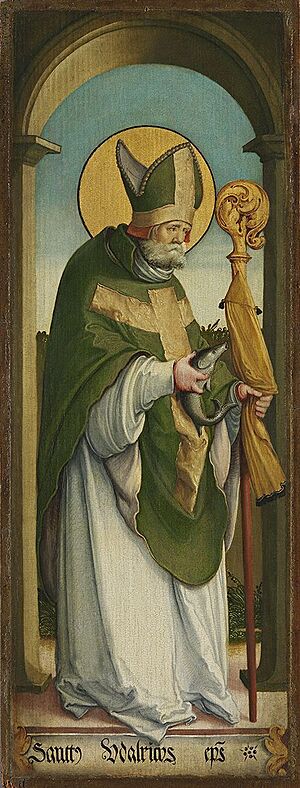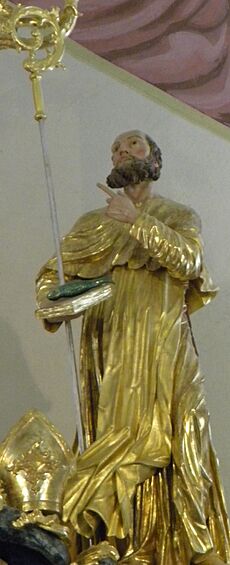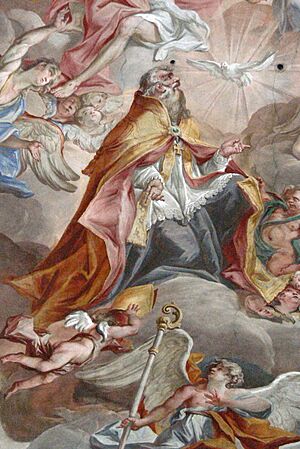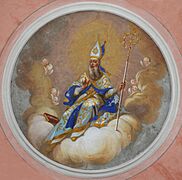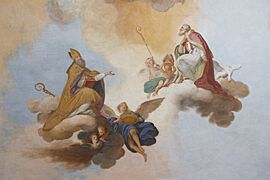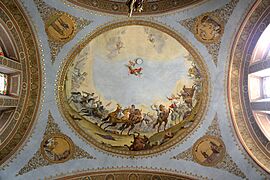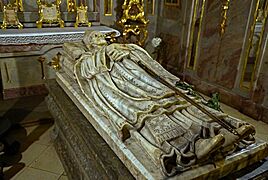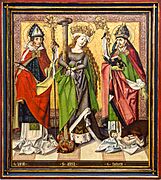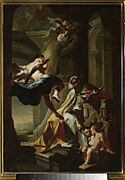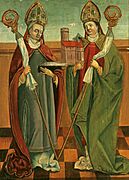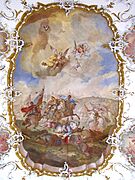Ulrich of Augsburg facts for kids
Quick facts for kids SaintUlrich of Augsburg |
|
|---|---|
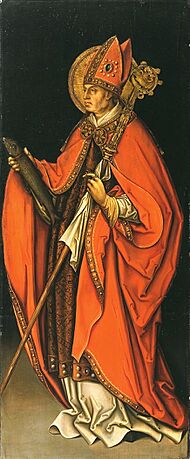
Oil painting by Leonhard Beck
|
|
| Bishop of Augsburg | |
| Born | 890 Kyburg, now Switzerland |
| Died | 4 July 973 (aged 82 or 83) Augsburg, Holy Roman Empire |
| Venerated in | Eastern Orthodox Church Catholic Church |
| Canonized | 4 July 993 by Pope John XV |
| Feast | 4 July |
| Attributes | Bishop holding a fish; at dinner with Saint Wolfgang; rewarding a messenger with a goose leg, which turns into a fish on Friday morning; giving a garment to a beggar; with Saint Afra; riding through a river on horseback as his companion sinks; with a cross given him by an angel |
| Patronage | Against birth complications; against faintness; against fever; against mice and moles; diocese of Augsburg, Germany; happy death; weavers; San Dorligo della Valle |
Ulrich of Augsburg (born 890 – died 4 July 973) was an important leader in the Holy Roman Empire. He served as the Bishop of Augsburg, a major city in what is now Germany. He was the very first saint to be officially recognized by the Pope, not just by local church leaders.
Contents
Meet Saint Ulrich: A Brave Bishop
Ulrich's Early Life and Education
Most of what we know about Ulrich comes from a book called Life of St Ulrich. It was written by Gerhard of Augsburg between 982 and 993. Ulrich was born in 890 in a place called Kyburg, which is now in Switzerland. His father was Hupald, a Count, and his mother was Dietpirch. His family was connected to powerful rulers of the time.
When Ulrich was seven, he was sent to the monastery of St. Gall. He was a sickly child but proved to be a brilliant student. While there, he became friends with a woman named Wiborada. She was a recluse, meaning she lived a quiet, religious life. Wiborada predicted that Ulrich would one day become a bishop.
Ulrich decided he wanted to become a priest. He later went to live with his relative, Adalbero, who was the Bishop of Augsburg. Ulrich worked as his chamberlain, helping with household duties. After Adalbero died, Ulrich returned home. He then joined the court of King Henry I of Germany.
Becoming the Bishop of Augsburg
Thanks to his uncle and other family members, Ulrich was chosen to be the bishop of Augsburg. King Henry I of Germany appointed him, and he officially became bishop on December 28, 923. Ulrich wanted to improve the behavior and training of the priests in his area.
He worked hard to make the church in Augsburg strong and respected. He improved schools and started new ones. He also made sure to visit churches and hold meetings to keep priests disciplined. Ulrich was very kind to the poor and rebuilt many churches and monasteries that had fallen apart. He even built new churches dedicated to Saint Afra and Saint John. He also started a monastery for Benedictine nuns.
To get important relics (holy objects), Ulrich traveled to Rome twice. The German emperor Otto I the Great also gave Ulrich the special right to make his own coins.
Loyalty to the Emperor
During a conflict between Emperor Otto I and his son, Liudolf, Ulrich stayed loyal to the Emperor. He protected a castle called Schwabmünchen for Otto. In 954, when Otto and Liudolf were about to fight, Ulrich and another bishop helped them make peace. Ulrich convinced Liudolf and Otto's son-in-law to ask the king for forgiveness.
Defending Against Invaders
Magyars, a group of invaders, often attacked the lands of Bavaria and Swabia. Ulrich played a key role in defending Augsburg. He ordered a strong stone wall to be built around the city. Many churches and buildings were destroyed during these attacks, but Ulrich later rebuilt them all.
In 955, the Magyars reached Augsburg and surrounded the city. It was thanks to Ulrich's bravery and leadership that Augsburg managed to hold out. This gave Emperor Otto enough time to arrive with his army. Ulrich's biographer, Gerhard, wrote that Bishop Ulrich led the city's defense.
On the first day of the attack, Ulrich rode out to encourage the soldiers. He wore his church robes and inspired his men with words from the Bible. The fiercest fighting happened on August 8 at the eastern gate. The Hungarians tried to break through in large numbers. But Ulrich's men bravely defended the gate and killed the enemy leader, forcing the Hungarians to retreat. That night, Ulrich worked to repair and strengthen the city walls.
The next day, the Hungarians launched a bigger attack. But then, news arrived that the German army was close. The siege was stopped. Ulrich's ability to defend the city bought valuable time for the Emperor.
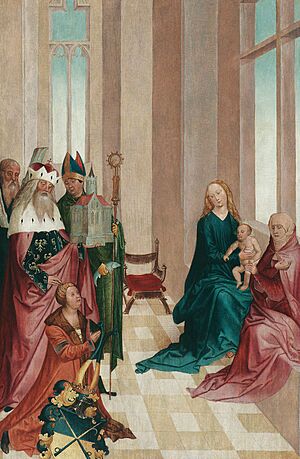
Ulrich also helped in the big victory at the Battle of Lechfeld on August 10, 955. This battle finally defeated the invaders. However, some historians say Ulrich himself did not fight in the battle.
Ulrich's Character and Later Years
Ulrich expected high moral standards from himself and everyone around him. He was also very loyal to the Emperor, acting as a strong supporter of the government's policies. He often attended important meetings and courts held by the king.
In 972, Ulrich attended a meeting where he had to defend himself. He was accused of favoring his nephew, Adalbero, whom he had appointed to help him. Ulrich wanted to retire to a monastery because he was ill. He did eventually resign as bishop and went to Ottobeuren Abbey, where he became the abbot.
On the morning of July 4, 973, Ulrich prepared for his death. He had ashes spread on the ground in the shape of a cross and was placed upon it. His nephew arrived with a message from Emperor Otto II. As the sun rose, and while priests sang prayers, Ulrich passed away. He was buried at the St. Afra church in Augsburg, which he had rebuilt. Later, a new church, St. Ulrich and Afra, was built in the same spot.
Veneration and Miracles
It is said that when Ulrich became too old to say Mass, angels would come to help him. Places named after him are believed to have healing powers. An old and beautiful drawing from the tenth century shows his early popularity.
Many miracles were said to have happened at his grave. Just 20 years after his death, Ulrich was officially made a saint by Pope John XV on July 4, 993. He was the first saint to be canonized (officially recognized as a saint) by a Pope, rather than by local church leaders.
Patronage
Along with Saint Afra and Simpert, Ulrich is a patron saint of Augsburg. A legend says that pregnant women who drank from his chalice (a special cup) would have easy deliveries. Because of this, he became known as a patron saint for pregnant women and easy births. Touching his pastoral cross was also believed to heal people bitten by rabid dogs.
Ulrich's worship was brought to America by German Catholic farmers. They settled in central Minnesota in the 1850s. Along with Magnus of Füssen, Ulrich was believed to have helped defeat a terrible Rocky Mountain locust plague in 1856-1857. Both saints are still honored in that area with pilgrimages and religious parades.
Gallery
-
The glorification of Saint Ulrich and Saint Martin
-
Saints Ulrich of Augsburg, Saint Afra and Simpert
-
Saint Ulrich and Saint Wolfgang, 1510


